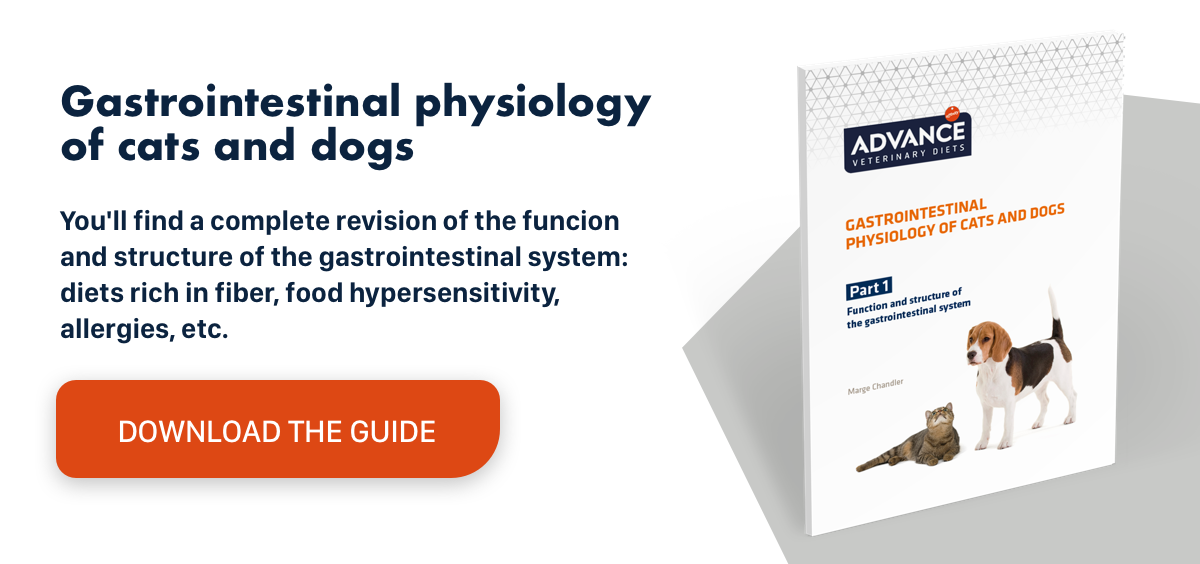Diarrhoea in dogs: diet in chronic processes
Given the difficulties of managing diarrhoea in dogs, Affinity Petcare conducted a clinical study to assess the efficacy and performance of diet in the control of chronic inflammatory enteropathies in dogs. The study consisted of administering a hypoallergenic diet or a highly digestible diet supplemented with bioactive plasma proteins and assessing its effect on dogs with chronic enteropathies.
[toc:ul CONTENTS]
Materials and methods
The study selected 77 dogs with suspected chronic enteropathies. The diagnosis was confirmed in 44 cases. Eventually, 37 dogs were included in the study.
These were divided into two groups: a hypoallergenic (HA) and a gastroenteritis (GE) group based on their medical history.
The HA group contained 30 dogs that had never followed an exclusion diet before. Unresponsive dogs were subsequently changed to the GE group. The hypoallergenic diet was Advance Veterinary Diets (AVD) Hypoallergenic, consisting of low-molecular-weight hydrolysed and purified soy protein and corn flour with no protein residues. It is generally used as an exclusion diet for the diagnosis and management of suspected food sensitivities.
The GE group comprised 7 dogs that had never previously followed an exclusion diet. This group received the highly digestible Advance Veterinary Diets (AVD) Gastroenteric diet, based on chicken and rice to improve digestibility. The protein source is also suitable for the treatment of gastrointestinal diseases and it is supplemented with bioactive plasma proteins. It is indicated for diarrhoea in dogs with gastrointestinal problems.
Twelve dogs underwent endoscopy before and after treatment. Samples were sent for histopathological analysis using the WSAVA index. Blood and faecal samples were also obtained from all the dogs.
Disease improvement was evaluated using the canine chronic enteropathy clinical activity index (CCECAI). This index scores the same parameters as the canine inflammatory bowel disease activity index (CIBDAI) as well as the level of albumin and the presence of pruritus and ascites or peripheral oedema.

Results for diarrhoea in dogs
Most dogs improved after eating one of the diets (85%):
- Symptoms disappeared in 58% simply by changing diet. In addition, four other dogs that were treated with opioids and gastroprotectants following the endoscopy and due to other health problems also improved with the diet, giving a total of 70% of dogs with chronic enteropathy which improved with diet.
- No statistically significant histopathological differences were found between the pre- and post-treatment duodenal biopsies in the 12 dogs that underwent biopsy. There was a tendency for the WSAVA index to decrease after treatment.
Histopathological scores tended to decrease after treatment, but the differences were not significant in this group of dogs (p = 0.1121). The horizontal black bars illustrate the mean and standard error of the mean. The coloured dots indicate the individual values for each dog.
The clinical signs disappeared in a few days to weeks in most dogs. Weight recovery was more heterogeneous.
Both diets (HA and GE) presented lower scores on the CCECAI activity index after treatment. No recurrence was observed at the end of follow-up (8–32 months).
Conclusions
- The right diet may be the only treatment necessary for dogs with chronic enteropathies.
- The CCECAI index (indicating disease activity) improved significantly after dietary treatment.
- The WSAVA index tended to be lower after dietary treatment.
- The clinical improvement was rapid (1–12 weeks) in all cases.
